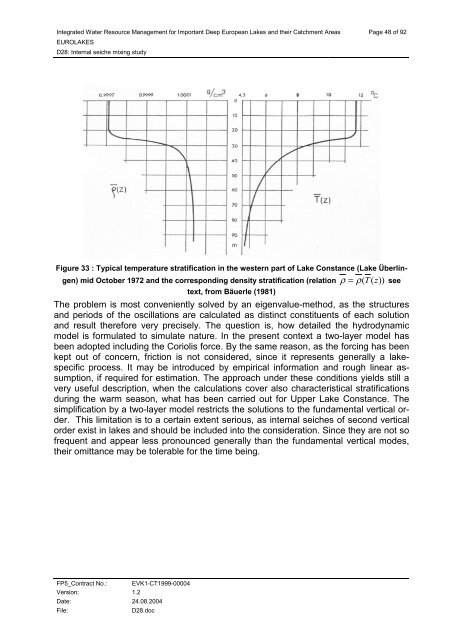D28: Internal seiche mixing study - Hydromod
D28: Internal seiche mixing study - Hydromod
D28: Internal seiche mixing study - Hydromod
Create successful ePaper yourself
Turn your PDF publications into a flip-book with our unique Google optimized e-Paper software.
Integrated Water Resource Management for Important Deep European Lakes and their Catchment Areas<br />
EUROLAKES<br />
<strong>D28</strong>: <strong>Internal</strong> <strong>seiche</strong> <strong>mixing</strong> <strong>study</strong><br />
FP5_Contract No.: EVK1-CT1999-00004<br />
Version: 1.2<br />
Date: 24.08.2004<br />
File: <strong>D28</strong>.doc<br />
Page 48 of 92<br />
Figure 33 : Typical temperature stratification in the western part of Lake Constance (Lake Überlingen)<br />
mid October 1972 and the corresponding density stratification (relation ρ = ρ(<br />
T ( z))<br />
see<br />
text, from Bäuerle (1981)<br />
The problem is most conveniently solved by an eigenvalue-method, as the structures<br />
and periods of the oscillations are calculated as distinct constituents of each solution<br />
and result therefore very precisely. The question is, how detailed the hydrodynamic<br />
model is formulated to simulate nature. In the present context a two-layer model has<br />
been adopted including the Coriolis force. By the same reason, as the forcing has been<br />
kept out of concern, friction is not considered, since it represents generally a lakespecific<br />
process. It may be introduced by empirical information and rough linear assumption,<br />
if required for estimation. The approach under these conditions yields still a<br />
very useful description, when the calculations cover also characteristical stratifications<br />
during the warm season, what has been carried out for Upper Lake Constance. The<br />
simplification by a two-layer model restricts the solutions to the fundamental vertical order.<br />
This limitation is to a certain extent serious, as internal <strong>seiche</strong>s of second vertical<br />
order exist in lakes and should be included into the consideration. Since they are not so<br />
frequent and appear less pronounced generally than the fundamental vertical modes,<br />
their omittance may be tolerable for the time being.









